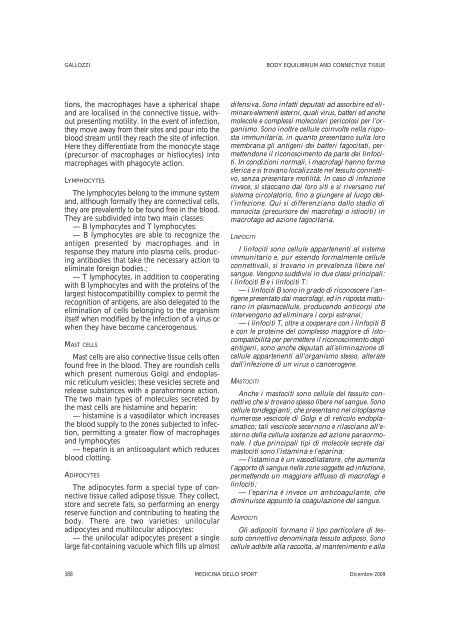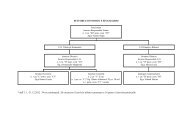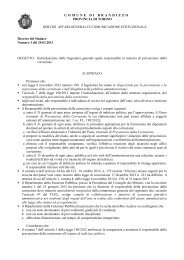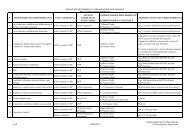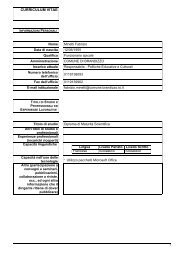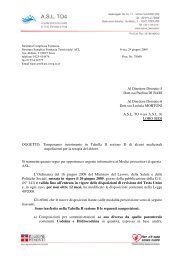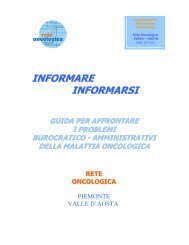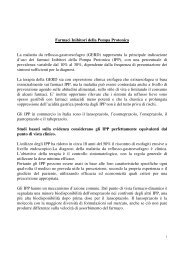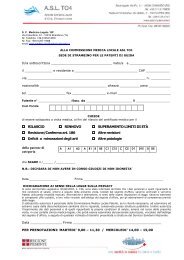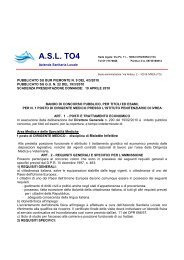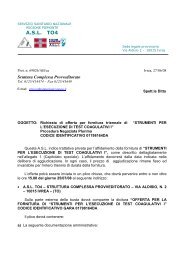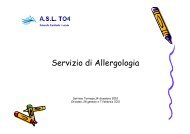Articolo sulla casistica delle non idoneità allo sport agonistico in ...
Articolo sulla casistica delle non idoneità allo sport agonistico in ...
Articolo sulla casistica delle non idoneità allo sport agonistico in ...
Create successful ePaper yourself
Turn your PDF publications into a flip-book with our unique Google optimized e-Paper software.
GALLOZZI BODY EQUILIBRIUM AND CONNECTIVE TISSUE<br />
tions, the macrophages have a spherical shape<br />
and are localised <strong>in</strong> the connective tissue, without<br />
present<strong>in</strong>g motility. In the event of <strong>in</strong>fection,<br />
they move away from their sites and pour <strong>in</strong>to the<br />
blood stream until they reach the site of <strong>in</strong>fection.<br />
Here they differentiate from the monocyte stage<br />
(precursor of macrophages or histiocytes) <strong>in</strong>to<br />
macrophages with phagocyte action.<br />
LYMPHOCYTES<br />
The lymphocytes belong to the immune system<br />
and, although formally they are connectival cells,<br />
they are prevalently to be found free <strong>in</strong> the blood.<br />
They are subdivided <strong>in</strong>to two ma<strong>in</strong> classes:<br />
— B lymphocytes and T lymphocytes:<br />
— B lymphocytes are able to recognize the<br />
antigen presented by macrophages and <strong>in</strong><br />
response they mature <strong>in</strong>to plasma cells, produc<strong>in</strong>g<br />
antibodies that take the necessary action to<br />
elim<strong>in</strong>ate foreign bodies.;<br />
— T lymphocytes, <strong>in</strong> addition to cooperat<strong>in</strong>g<br />
with B lymphocytes and with the prote<strong>in</strong>s of the<br />
largest histocompatibility complex to permit the<br />
recognition of antigens, are also delegated to the<br />
elim<strong>in</strong>ation of cells belong<strong>in</strong>g to the organism<br />
itself when modified by the <strong>in</strong>fection of a virus or<br />
when they have become cancerogenous.<br />
MAST CELLS<br />
Mast cells are also connective tissue cells often<br />
found free <strong>in</strong> the blood. They are roundish cells<br />
which present numerous Golgi and endoplasmic<br />
reticulum vesicles; these vesicles secrete and<br />
release substances with a parahormone action.<br />
The two ma<strong>in</strong> types of molecules secreted by<br />
the mast cells are histam<strong>in</strong>e and hepar<strong>in</strong>:<br />
— histam<strong>in</strong>e is a vasodilator which <strong>in</strong>creases<br />
the blood supply to the zones subjected to <strong>in</strong>fection,<br />
permitt<strong>in</strong>g a greater flow of macrophages<br />
and lymphocytes<br />
— hepar<strong>in</strong> is an anticoagulant which reduces<br />
blood clott<strong>in</strong>g.<br />
ADIPOCYTES<br />
The adipocytes form a special type of connective<br />
tissue called adipose tissue. They collect,<br />
store and secrete fats, so perform<strong>in</strong>g an energy<br />
reserve function and contribut<strong>in</strong>g to heat<strong>in</strong>g the<br />
body. There are two varieties: unilocular<br />
adipocytes and multilocular adipocytes:<br />
— the unilocular adipocytes present a s<strong>in</strong>gle<br />
large fat-conta<strong>in</strong><strong>in</strong>g vacuole which fills up almost<br />
difensiva. Sono <strong>in</strong>fatti deputati ad assorbire ed elim<strong>in</strong>are<br />
elementi esterni, quali virus, batteri ed anche<br />
molecole e complessi molecolari pericolosi per l’organismo.<br />
Sono <strong>in</strong>oltre cellule co<strong>in</strong>volte nella risposta<br />
immunitaria, <strong>in</strong> quanto presentano <strong>sulla</strong> loro<br />
membrana gli antigeni dei batteri fagocitati, permettendone<br />
il riconoscimento da parte dei l<strong>in</strong>fociti.<br />
In condizioni normali, i macrofagi hanno forma<br />
sferica e si trovano localizzate nel tessuto connettivo,<br />
senza presentare motilità. In caso di <strong>in</strong>fezione<br />
<strong>in</strong>vece, si staccano dai loro siti e si riversano nel<br />
sistema circolatorio, f<strong>in</strong>o a giungere al luogo dell’<strong>in</strong>fezione.<br />
Qui si differenziano d<strong>allo</strong> stadio di<br />
monocita (precursore dei macrofagi o istiociti) <strong>in</strong><br />
macrofago ad azione fagocitaria.<br />
LINFOCITI<br />
I l<strong>in</strong>fociti sono cellule appartenenti al sistema<br />
immunitario e, pur essendo formalmente cellule<br />
connettivali, si trovano <strong>in</strong> prevalenza libere nel<br />
sangue. Vengono suddivisi <strong>in</strong> due classi pr<strong>in</strong>cipali:<br />
i l<strong>in</strong>fociti B e i l<strong>in</strong>fociti T:<br />
— i l<strong>in</strong>fociti B sono <strong>in</strong> grado di riconoscere l’antigene<br />
presentato dai macrofagi, ed <strong>in</strong> risposta maturano<br />
<strong>in</strong> plasmacellule, producendo anticorpi che<br />
<strong>in</strong>tervengono ad elim<strong>in</strong>are i corpi estranei;<br />
— i l<strong>in</strong>fociti T, oltre a cooperare con i l<strong>in</strong>fociti B<br />
e con le prote<strong>in</strong>e del complesso maggiore di istocompatibilità<br />
per permettere il riconoscimento degli<br />
antigeni, sono anche deputati all’elim<strong>in</strong>azione di<br />
cellule appartenenti all’organismo stesso, alterate<br />
dall’<strong>in</strong>fezione di un virus o cancerogene.<br />
MASTOCITI<br />
Anche i mastociti sono cellule del tessuto connettivo<br />
che si trovano spesso libere nel sangue. Sono<br />
cellule tondeggianti, che presentano nel citoplasma<br />
numerose vescicole di Golgi e di reticolo endoplasmatico;<br />
tali vescicole secer<strong>non</strong>o e rilasciano all’esterno<br />
della cellula sostanze ad azione paraormonale.<br />
I due pr<strong>in</strong>cipali tipi di molecole secrete dai<br />
mastociti sono l’istam<strong>in</strong>a e l’epar<strong>in</strong>a:<br />
— l’istam<strong>in</strong>a è un vasodilatatore, che aumenta<br />
l’apporto di sangue nelle zone soggette ad <strong>in</strong>fezione,<br />
permettendo un maggiore afflusso di macrofagi e<br />
l<strong>in</strong>fociti;<br />
— l’epar<strong>in</strong>a è <strong>in</strong>vece un anticoagulante, che<br />
dim<strong>in</strong>uisce appunto la coagulazione del sangue.<br />
ADIPOCITI<br />
Gli adipociti formano il tipo particolare di tessuto<br />
connettivo denom<strong>in</strong>ata tessuto adiposo. Sono<br />
cellule adibite alla raccolta, al mantenimento e alla<br />
388 MEDICINA DELLO SPORT Dicembre 2009


